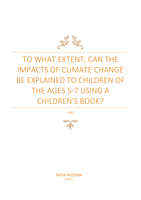Summary
Summary EPQ: Artifact report example
- Course
- Institution
- Book
Hi! For my EPQ, I made a children book about climate change. I knew I wanted to do geog at Uni and wanted to put the impacts in a way that would be understood to a child. We need to next gen to understand it, because in this current political climate, its being ignored. With the artifact, you have...
[Show more]




